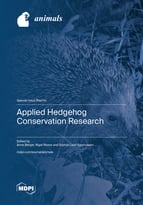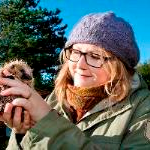Applied Hedgehog Conservation Research
A special issue of Animals (ISSN 2076-2615). This special issue belongs to the section "Wildlife".
Deadline for manuscript submissions: closed (31 October 2023) | Viewed by 153538
Special Issue Editors
Interests: behavioural and evolutionary ecology; chronobiology; wildlife telemetry; reintroduction and conservation of mammals; urban ecology; stress detection in wildlife; animal welfare; wildlife detection dogs; Przewalski horses; European hedgehog; roe deer
Special Issues, Collections and Topics in MDPI journals
Interests: hedgehogs - especially behaviour and ecology, biotelemetry, wildlife ecology and conservation, urban ecology, animal welfare, citizen science
Interests: hedgehog conservation; wildlife biology; biodiversity; conservation; animal communication; genetics; zoonoses
Special Issues, Collections and Topics in MDPI journals
Special Issue Information
Dear Colleagues,
Despite their protected status and widespread popularity, the abundance of European hedgehogs (Erinaceus europaeus) is steadily or strongly declining in several European countries, especially in rural areas.
This decline seems to be caused by a range of different factors, mainly anthropogenic, including habitat loss and fragmentation, a reduction in the availability of invertebrate prey and the use of pesticides in general, and dangers to hedgehogs living in residential gardens as well as negative interspecific influences.
To stop this decline, there is an urgent need for action, but it is essential to discover and understand the causes for the decline and investigate the effectiveness and potential for improvement of different conservation initiatives. Therefore, this Special Issue will be dedicated to studies that contribute to the development of improved protection measures for the hedgehog. We encourage the submission of manuscripts exploring topics such as:
- Studies showing significant impacts on the behaviour and population dynamics of hedgehogs;
- Proven and effective protection measures for hedgehogs;
- Hedgehog rehabilitation;
- Post-release monitoring of rehabilitated hedgehogs;
- Reasons for the population decline and how to reduce these risks;
- Engaging the public in conservation initiatives and the effectiveness of these programmes;
- Methods producing reliable population density estimates;
- Methods that improve long-term and large-scale monitoring;
- Genetic studies of hedgehog populations.
We look forward to receiving your important contribution, as this Special Issue will be a relevant addition to the existing literature by focusing primarily on applied conservation measures for the protection of European hedgehogs.
Dr. Anne Berger
Dr. Nigel Reeve
Dr. Sophie Lund Rasmussen
Guest Editors
Manuscript Submission Information
Manuscripts should be submitted online at www.mdpi.com by registering and logging in to this website. Once you are registered, click here to go to the submission form. Manuscripts can be submitted until the deadline. All submissions that pass pre-check are peer-reviewed. Accepted papers will be published continuously in the journal (as soon as accepted) and will be listed together on the special issue website. Research articles, review articles as well as short communications are invited. For planned papers, a title and short abstract (about 100 words) can be sent to the Editorial Office for announcement on this website.
Submitted manuscripts should not have been published previously, nor be under consideration for publication elsewhere (except conference proceedings papers). All manuscripts are thoroughly refereed through a single-blind peer-review process. A guide for authors and other relevant information for submission of manuscripts is available on the Instructions for Authors page. Animals is an international peer-reviewed open access semimonthly journal published by MDPI.
Please visit the Instructions for Authors page before submitting a manuscript. The Article Processing Charge (APC) for publication in this open access journal is 2400 CHF (Swiss Francs). Submitted papers should be well formatted and use good English. Authors may use MDPI's English editing service prior to publication or during author revisions.
Keywords
- European hedgehog
- Erinaceus europaeus
- wildlife conservation
- urban ecology
- population dynamics
- wildlife diseases
- population monitoring
- genetic population structure
- habitat fragmentation
- habitat connectivity
- disturbance
- behaviour
- biotelemetry









